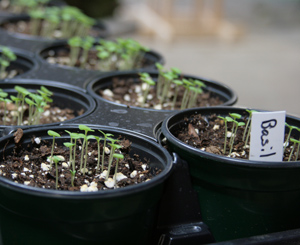What To Do in the Garden in May & June

Basil seedlings
May Edibles:
It’s your last chance to start some slow-growing seedlings early in the month, such as tomatoes and parsley. Soak parsley seeds in lukewarm water for a few hours first. Consider getting a heated germination mat to accelerate germination. After germination, take the plants off the mat and hang fluorescent lights about four inches above them. It’s OK for seedlings to have the lights on 24 hours a day—it will accelerate growth.
Around May 10is when I start heat-loving, long-season plants such as winter squash, melons, and okra. Cucumbers and summer squash can also be started then, or you can wait until later in May or June, and seed them directly outdoors, as they are faster growing.
Early in May, there is still time to direct seed some of the cool-tolerant veggies, such as spinach, lettuce, and radishes, that are quick to harvest. It’s probably too late to plant peas, because they won’t produce before the real heat arrives.
Late in the month (or early in June) should be safe to plant your frost-sensitive, heat-loving seedlings outside, especially if you applied black plastic or IRT (infrared transmitting) mulch to warm up the soil in the veggie garden. Use rowcover to keep the plants warmer and prevent early insect attack. For real heat lovers like melons, you can leave the rowcover on for a few weeks, but be sure to remove it when they start blooming.
Now is a good time to fertilize your blueberries with the acid fertilizer ammonium sulfate (notaluminum sulfate), and/or apply elemental sulfur to keep the pH acidic enough.
May Ornamentals:
The average last frost occurs in mid-May in much of Upstate NY, but frosts in late May are quite common in some areas. Be prepared to cover sensitive perennials such as Japanese painted fern, kirengeshoma, true lilies, and even hostas, if a hard frost is predicted. I keep old blankets and sheets for this purpose (do not use plastic).
May and June are the best times to prune those woody plants that are considered “bleeders.” Maples, birch, yellowwood, magnolia, linden, willow, and nut trees are just a few trees that are best pruned in this time frame, after the sap is finished running. Peach trees are also best pruned when in bloom or just afterwards (see the Cornell Guide to Growing Fruit at Homefor details).
The first part of May is still a good time to divide hardy perennials such as daylilies, hosta, and phlox. It’s also when fall bloomers like asters and mums can be divided. Be sure the roots are moist first and be prepared to replant (or pot them up) immediately. After transplanting I use milk crates or buckets to keep the sun off for a couple of days if the weather turns hot and sunny. Now is a good time to pot up (or move) seedlings if you’ve allowed your perennials to self-sow. If you have double-flowered peonies, you should install peony cages early in the month to support the heavy blooms.
Keep applying deer repellent on the succulent new growth as needed.
Prune early-spring–flowering shrubs like forsythia right after they bloom.
Check your ash trees for emerald ash borer and decide if treatment or removal is warranted. Young, healthy trees respond to treatment better than old, declining trees. If you have considerable land, consider leaving some ash trees alone, in case they prove to be resistant.
Either April or May is a good time to use your germination heat mat for getting heat-loving tropical “bulbs” such as caladiums started. Use shallow pots until they sprout. Depending on your microclimate, you may need to pot them up again before they can be safely planted outside. Other tender bulbs or tubers, such as dahlias and cannas, can also be potted up early, but should grow at normal indoor room temperature.
Keep your lawn mower set to three inches or higher, be sure the blade is sharp, and mow frequently as needed. Wait until early fall to fertilize, will encourage root growth rather than top growth.
June Edibles:
Keep up with the weeding! Don’t let the weeds go to seed. After the soil has warmed up sufficiently for peppers and tomatoes, go ahead and put down mulch. Stake or cage your tomatoes before it’s too late. Plant Brussels sprouts transplants. There is still time to sow cucumbers and summer squash. Plant carrots in late June to avoid the carrot maggot, which usually has only one generation a year.
Now it’s time to harvest peas and strawberries! Juneberries (a.k.a. amelanchier or shadblow) will be ripe in May or June also. Finish harvesting rhubarb and asparagus by mid-month.
After fruit trees drop their excess, thin the remaining fruit as needed to get bigger, better fruit (see the Cornell guide cited above).
Install a rain gauge or consider getting an electronic weather station that delivers data such as temperatures, wind speed, and rainfall inches to a display inside the house.
June Ornamentals:
Keep weeding!
Pinch or cut back perennials (before the end of the month) that bloom in late summer or fall, in order to make them shorter and bushier—asters, mums, boltonia, etc. See The Well-Tended Perennial Gardenby Tracy Di Sabato-Aust for details.
Deadhead peonies, bearded irises, and rhododendrons, among others. Look for iris flower fly maggots, especially in Siberian iris, but also in bearded iris.
Dig up spring bulbs that need dividing (leave daffodils to the last to allow the foliage more time to feed the bulbs).
Mid-June is the usual time to take softwood cuttings from deciduous shrubs.
Early in June, it should be safe to move some houseplants outside for the summer. Avoid sunburned leaves by siting them in some shade.
Go on garden tours—they are great fun and there are lots of ideas to borrow from fellow gardeners!
—Pat Curran and the Tompkins County Master Gardeners
Views: 0





